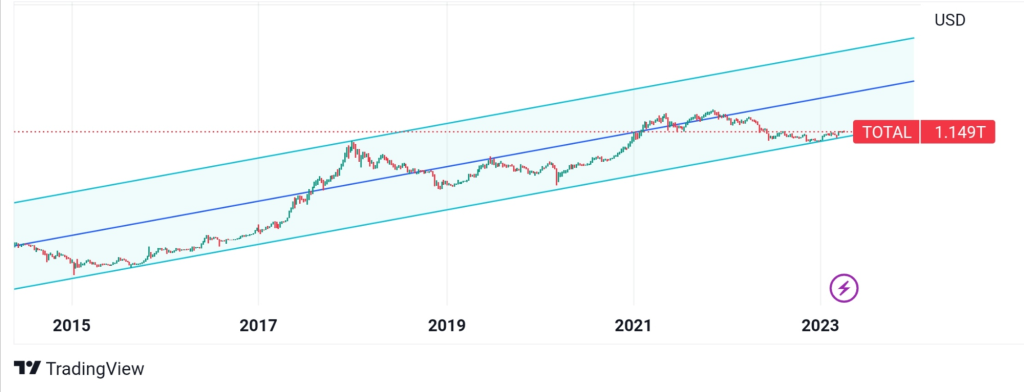The world of cryptocurrency can be both thrilling and perplexing, especially for newcomers navigating the diverse metrics and jargon. Two frequently encountered terms are market capitalization (market cap) and product labeling. While we’ve explored these concepts previously, another layer of complexity arises with market cap aggregations, such as Total 1 and Total 2. This comprehensive article delves into the intricacies of these aggregations, empowering you to make informed decisions in the dynamic crypto market.
Understanding Market Capitalization:
Before diving into aggregations, let’s solidify the foundation: market capitalization. It represents the total market value of all outstanding units of a particular cryptocurrency. In simpler terms, it’s the current price per coin multiplied by the total number of coins in circulation.
Why is market cap important?
- Gauging a crypto’s overall size and influence: Higher market cap generally indicates wider adoption and potentially greater stability. However, smaller market cap coins can offer higher growth potential.
- Comparing different cryptocurrencies: Market cap allows you to compare the relative sizes and potential impacts of different crypto projects.
Remember: Market cap is a dynamic figure, constantly changing with price fluctuations and circulating supply variations.
Introducing Market Cap Aggregations:
Now, let’s venture into the realm of market cap aggregations. These are essentially combined market caps of multiple cryptocurrencies, offering a broader perspective on specific market segments. Popular examples include:
- Total 1 (TOTAL): Represents the combined market cap of the top 125 cryptocurrencies listed on TradingView’s Crypto Coins Screener.
- Total 2 (TOTAL2): Similar to Total 1, but it excludes Bitcoin’s market cap, providing a view of the market without its dominant influence.
Additional Variations:
- Total 3 (TOTAL3): Excludes both Bitcoin and Ethereum.
- TOTALDEFI: Focuses solely on Decentralized Finance (DeFi) coins.
- Other platforms may have their own variations with specific methodologies.
Benefits of Using Aggregations:
- Broader Market Overview: These metrics offer a quick snapshot of the overall cryptocurrency market health, providing insights into growth trends and potential bubbles.
- Altcoin Performance Analysis: Total 2 helps understand how altcoins collectively perform without Bitcoin’s significant influence, revealing potential opportunities or risks within the altcoin market.
- Comparative Analysis: By comparing different “Total” values, you can gauge the relative prominence of specific sectors or projects within the broader market.
Limitations to Consider:
- Oversimplification: These aggregated values don’t capture the individual performance and intricacies of each cryptocurrency. It’s crucial to delve into individual projects for detailed analysis.
- Methodology Dependence: The specific criteria for “top” coins and inclusion/exclusion may vary across platforms, leading to potential discrepancies.
- Market Cap Volatility: Remember, market cap is dynamic and fluctuates with price movements. These figures represent a snapshot, not a definitive long-term indicator.
Beyond the Basics:
- Explore Different Providers: Each platform might have its own methodology for calculating market cap and choosing “top” coins. Familiarize yourself with different providers and their unique methods.
- Focus on Individual Projects: While “Total” figures offer a starting point, don’t solely rely on them. Always evaluate individual projects based on their fundamentals, team, technology, and roadmap.
- Consider Other Metrics: Look beyond market cap when making investment decisions. Analyze trading volume, social media sentiment, and project adoption for a more comprehensive picture.

Putting Market Cap Aggregations to Work: Examples for Beginners and Advanced Users
Now that you’re equipped with the knowledge of market cap aggregations like Total 1 and Total 2, let’s explore how beginners and advanced users can leverage them in their crypto journeys:
For Beginners:
- Gaining Initial Insights: As a newcomer, understanding broad market trends can be overwhelming. Total 1 offers a quick and simple way to assess the overall health of the market. Is it experiencing rapid growth or a downturn? This can help you decide whether to invest or wait for a more favorable entry point.
- Identifying Potential Sectors: Looking at Total 2 can guide you towards exploring altcoins without the immediate influence of Bitcoin. This allows you to discover promising sectors like DeFi or NFTs, sparking your interest in further research.
- Comparing Investment Options: When considering specific cryptocurrencies, use market cap alongside other metrics like price and trading volume. Aggregations like Total 3 can help you compare the size and potential impact of different altcoins within your investment range.
Comparing Investment Options:
- Size and Potential Impact: When considering specific altcoins, use market cap alongside other metrics like price and trading volume. Compare different altcoins within your investment range using aggregations like Total 3 to get a sense of their relative size and potential impact.
Remember: Always prioritize responsible research and diversification as a beginner. Don’t base your investment decisions solely on these aggregations. Here are some additional tips:
- Treat Them as Starting Points: Use aggregations to initiate your research, not make immediate investment decisions. They offer a broad overview, but individual project analysis is crucial.
- Diversify Beyond Metrics: Don’t put all your eggs in one basket! Diversify your portfolio across different sectors, market caps, and even traditional assets to manage risk.
- Seek Guidance: Don’t hesitate to consult experienced investors or communities for advice and insights before making any investment decisions.
Examples of Beginner-Friendly Applications:
- Scenario 1: You’re interested in entering the crypto market but unsure where to start. You see Total 1 is trending upwards, indicating positive overall market sentiment. This encourages you to research further and explore potential investment options.
- Scenario 2: You hear about the potential of DeFi but feel overwhelmed by the number of projects. You check TotalDEFI and notice a specific sector within DeFi showing promising growth. This leads you to research promising projects within that sector for further consideration.
- Scenario 3: You’re comparing two altcoins with similar prices but notice one has a much higher market cap (reflected in Total 1). This prompts you to research the fundamentals and growth potential of each coin before making a decision.
For Advanced Users:
While beginners can benefit from market cap aggregations like Total 1 and Total 2 for initial insights and comparisons, professional users can leverage them in more sophisticated ways to support their investment strategies and market analysis. Here are some key applications:
Advanced Sector Analysis:
- Go beyond the basics: Explore platforms offering aggregations for specific sectors or niches. This allows you to deep-dive into areas like gaming tokens, stablecoins, or privacy coins, identifying undervalued gems or assessing sector dominance.
- Compare niche trends: Analyze performance differences between various sub-sectors within a broader category. For example, compare DeFi lending protocols with DEX aggregators using sector-specific aggregations.
- Identify emerging opportunities: Track trends in new or rapidly growing sectors using specific aggregations to spot potential early investment opportunities.
Monitoring Portfolio Diversification:
- Quantify portfolio exposure: Use aggregations to measure your portfolio’s diversification across different market cap ranges (large, mid, small). This helps you maintain a balanced risk profile and avoid overexposure to specific segments.
- Evaluate allocation adjustments: Based on market conditions and your risk tolerance, use aggregations to guide decisions on increasing or decreasing exposure to certain market cap ranges.
- Compare against benchmarks: Benchmark your portfolio’s market cap distribution against relevant indices or other investment strategies for performance evaluation.
Identifying Market Sentiment:
- Spot sudden shifts: Monitor changes in specific aggregations like Total 2. A rapid rise might indicate growing interest in altcoins, prompting you to re-evaluate your investment strategy and potentially adjust portfolio allocations.
- Gauge investor confidence: Analyze changes in Total 1 alongside other indicators like trading volume and social media sentiment to gain a broader understanding of investor confidence in the overall market.
- Identify potential bubbles: If a specific sector’s aggregation shows rapid, unsustainable growth, it might signal a potential bubble, prompting you to exercise caution and consider rebalancing your portfolio.
Remember: Professional users should have a strong understanding of individual projects, technical analysis, and fundamental factors beyond solely relying on aggregations.
Additional Tips:
- Combine quantitative and qualitative analysis: While aggregations offer numerical insights, don’t neglect project fundamentals, team analysis, and technological assessments for informed decisions.
- Beware of methodology differences: Understand how different platforms calculate market cap and choose “top” coins to avoid misinterpretations and misleading comparisons.
- Use aggregations to refine your research: Don’t blindly follow trends; use aggregations to narrow down your research scope and identify projects warranting deeper analysis.
By leveraging market cap aggregations strategically and incorporating them into a comprehensive investment approach, professional users can gain valuable insights, refine their analysis, and make informed decisions in the ever-evolving cryptocurrency landscape.
Additional Tips:
- Don’t chase trends blindly: Use aggregations as starting points for further research, not definitive investment decisions.
- Be mindful of methodology differences: Understand how different platforms calculate market cap and choose “top” coins to avoid misinterpretations.
- Combine qualitative and quantitative analysis: Market cap aggregations are numerical tools; remember to consider project fundamentals, team, and technology for a holistic view.
Remember: Knowledge is power, and responsible research is key to navigating the dynamic world of crypto investments. By understanding the intricacies of market cap aggregations like Total 1, Total 2, and their extended family, you can make informed decisions and embark on your crypto journey with greater confidence.
